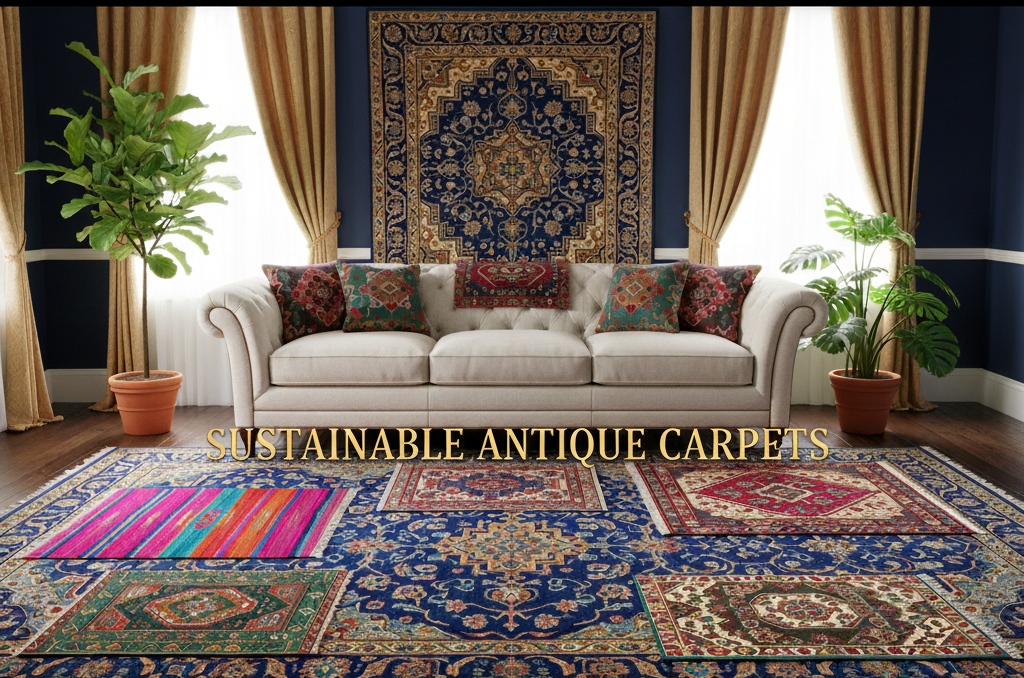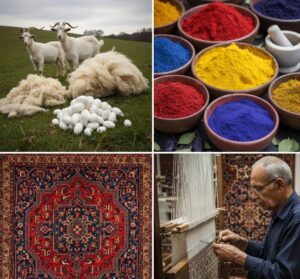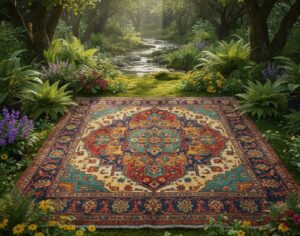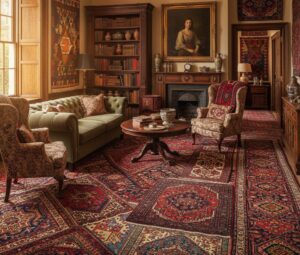The Green Luxury: Sustainable Antique Carpets
In today’s world, the move towards sustainability is not just a trend but a necessary shift.
Designing a sustainable home goes beyond choosing recycled materials or energy-efficient appliances. It’s about creating spaces that breathe history, craftsmanship, and authenticity — places that reject mass-produced trends in favour of pieces with purpose.
One such home decor, an essential part of our interiors, is carpets and rugs
Carpets are an essential part of interior decor, but one cannot ignore the environmental impact of carpet manufacturing.
In order to combat the negative impacts, the trend of eco-friendly carpets is gaining momentum.
This is where the venerable antique carpet emerges not just as a piece of décor, but as the pinnacle of sustainable luxury. More than a floor covering, a genuine antique rug is a piece of art, a slice of history, and a testament to an inherently eco-friendly, circular economy.
When you choose an antique or vintage carpet, you’re not just buying décor — you’re preserving artistry, reducing waste, and supporting an eco-friendly decor.
This guide is designed to provide you with insight into the sustainable antique and vintage carpets and how they contribute to a green environment.

Also Read: The Journey of Carpet Through Time
What Makes a Carpet Eco-Friendly?
A sustainable carpet is one made with respect for both people and the planet. Unlike synthetic, machine-made rugs that often rely on petroleum-based fibres and chemical dyes, sustainable carpets prioritise natural materials, traditional craftsmanship, and long-term durability. For example, an antique Persian carpet isn’t just a floor covering; it’s a handwoven legacy, made from natural materials. Sustainable antique carpets are built to last.
What Makes Antique Carpets Sustainable?

Antique carpets are sustainable because they reduce waste, as these carpets already exist, and there is no further manufacturing involved with them.
Sustainability in carpets is not just about what they’re made of, but how and why they’re made. These are the factors that make antique carpets sustainable:
- The Materials: Nature’s Own Luxury
Every antique carpet begins with the most essential ingredient — fibre. Unlike industrial carpets that use nylon or polyester, antique rugs are crafted from organic materials.
- Wool: Naturally renewable, flame-resistant, and biodegradable. Wool carpets self-clean to a degree, repel stains, and age gracefully.
- Silk: A rare, luxurious fibre that adds sheen and softness, often used in Persian or Mughal carpets for intricate detailing.
- Cotton: Commonly used as the warp foundation, adding stability and flexibility.
- Hemp & Jute: Earthy, rustic, and completely compostable — early examples of plant-based flooring long before “eco-friendly” was a trend.
- The Dye: Colour Without Compromise
Colour tells the soul of a carpet. In antique rugs, those deep reds, indigos, and ochres come from natural dyes extracted from roots, leaves, flowers, minerals, and even insects
- Madder Root → Rich reds and rust tones
- Indigo Plant → Deep blues
- Pomegranate Rind → Warm yellows and golds
- Walnut Husk → Earthy browns
- Cochineal → Vivid pinks and purples
Each hue carries centuries of experimentation and local knowledge, a science of sustainability long before the term existed.
- The Craftsmanship: Built to Outlast Trends
Modern rugs are often machine-tufted and glued together, designed for quick sales and quicker disposal. Antique carpets, by contrast, are hand-knotted masterpieces — a single piece can take months or even years to complete.
Each knot is tied by hand, forming patterns that symbolize love, protection, fertility, or community identity.
By valuing craftsmanship over convenience, antique carpets embody slow design — the opposite of fast décor. Every repair, every re-dyeing, every gentle wear mark adds character instead of rendering the piece obsolete.
Why Antique Carpets Are the Ultimate Sustainable Choice

When you choose an antique carpet, you’re extending the life of an existing creation instead of consuming new resources. That’s the foundation of a circular economy — reuse, restore, respect.
Here’s why antique carpets are inherently sustainable:
- Zero New Production Footprint
You’re not contributing to industrial emissions or synthetic waste — you’re re-homing an existing piece.
- Durability Beyond Compare
Antique rugs were built to survive centuries. The very fact that they’ve endured is proof of their resilience.
- Cultural Preservation
Supporting antique textiles helps keep traditional weaving knowledge alive, which modern mechanization often erases.
- Unique, Not Mass-Produced
No two antique carpets are the same — each carries regional identity, personal history, and artistic flair.
- Investment Value
Unlike fast décor, antique carpets often appreciate in value. They are assets that enrich both your space and your portfolio.
Designing Sustainable Interiors with Antique Carpets

Decorating sustainably doesn’t mean compromising style. In fact, integrating antique carpets into modern interiors adds depth, warmth, and sophistication that synthetic décor simply can’t replicate
Here’s how to make it work:
- Mix Old and New: Pair a bold, tribal rug with sleek modern furniture for contrast.
- Layering for Texture: Stack a smaller vintage carpet atop a neutral jute rug to create visual dimension.
- Focus on One Statement Piece: Let an antique carpet anchor the entire room — a story beneath your feet.
- Eco-friendly Maintenance: Use natural cleaning agents and sunlight airing instead of chemical detergents to maintain your antique rugs.
By choosing meaningful pieces over disposable ones, you create a home that feels lived-in, loved, and aligned with your values.
Giftex: A World Of Collectibles Auction
While antique carpets were once found only in dusty bazaars or high-end showrooms, the digital age has made these sustainable treasures accessible to everyone.
For collectors and conscious decorators alike, Giftex online auction house offers a curated world of vintage and antique collectibles. Known for connecting connoisseurs with authentic antique carpets, heritage shawls, and timeless décor, Giftex is more than an auction house — it’s a bridge between the past and future of sustainable living.
Giftex offer a dedicated platform for Textiles, showcasing rare carpets, rugs, and shawls.
Curated Selection: These platforms provide a vetted selection of unique pieces, ensuring authenticity and quality—a critical factor when investing in antiques.
Transparency: Online auctions offer a transparent way to acquire exceptional pieces.
Sustainability That Speaks Through Time
Sustainability isn’t a design trend — it’s a mindset. And few objects embody that mindset better than antique carpets. They remind us that luxury doesn’t have to be new, that beauty can be inherited, and that the most sustainable object is often the one already made.
So next time you think about updating your space, think beyond the showroom floor. Choose pieces that last, tell a story, and make a difference — one knot, one thread, one home at a time.






